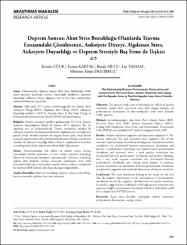| dc.contributor.author | Uğur, Mete | |
| dc.contributor.author | Kartal, Fatma | |
| dc.contributor.author | Mete, Burak | |
| dc.contributor.author | Tamam, Lut | |
| dc.contributor.author | Demirkol, Mehmet Emin | |
| dc.date.accessioned | 2022-06-10T08:45:47Z | |
| dc.date.available | 2022-06-10T08:45:47Z | |
| dc.date.issued | 2021 | en_US |
| dc.identifier.citation | UĞUR, K., KARTAL, F., METE, B., TAMAM, L., & DEMİRKOL, M. E. (2021). Deprem Sonrası Akut Stres Bozukluğu Olanlarda Travma Esnasındaki Çözülmenin, Anksiyete Düzeyi, Algılanan Stres, Anksiyete Duyarlılığı ve Deprem Stresiyle Baş Etme ile İlişkisi. Turk Psikiyatri Dergisi, 32(4). | en_US |
| dc.identifier.uri | https://www.turkpsikiyatri.com/PDF/C32S4/tr/tpd_c32_s4_253-260.pdf | |
| dc.identifier.uri | https://hdl.handle.net/20.500.12899/1141 | |
| dc.description.abstract | Amaç: Çalışmamızda, deprem sonrası Akut Stres Bozukluğu (ASB)
tanısı konulan hastalarda travma esnasındaki çözülmeye anksiyete
duyarlılığı, anksiyete düzeyi, algılanan stres ve baş etme stratejilerinin
etkisini belirlemeyi amaçladık.
Yöntem: ASB tanılı 477 hastaya sosyodemografik veri formu, Beck
Anksiyete Ölçeği (BAÖ), Algılanan Stres Ölçeği (ASÖ), Anksiyete
duyarlılığı indeksi-3 (ADİ-3), Deprem Stresi ile Baş Etme Ölçeği ve
Peritravmatik Dissosiyasyon Ölçeği (PDEQ) doldurtulmuştur.
Bulgular: Travma esnasında çözülme gelişmesinde %31,5’lik değişim
anksiyete duyarlılığının bilişsel alt boyutu, %7’si anksiyete, %1 ise
algılanan stres ile açıklanmaktadır. Travma esnasındaki çözülme ile
anksiyete arasında orta düzey pozitif yönde, algılanan stres arasında zayıf
pozitif yönde, olumlu düşünme ile negatif yönde zayıf, sosyal destek
arama ile negatif yönde çok zayıf ilişki bulunmuştur. Travma esnasındaki
çözülme ile anksiyete duyarlığı fiziksel, bilişsel, toplumsal alt boyutları
arasında pozitif yönde anlamlı orta düzey ilişki bulunmuştur.
Sonuç: Araştırmamızdan elde edilen en önemli sonuç; travma
esnasındaki çözülme gelişimine en fazla katkıyı anksiyete duyarlılığı
bilişsel alt boyutunun yaptığının saptanmasıdır. Anksiyete duyarlılığı
yüksek olan kişilerde travma esnasında çözülmenin daha fazla
deneyimlenebileceği ve travmadan sonraki süreçte ilerleyen zamanlarda
bu kişilerin TSSB riskinin daha fazla olacağını öngörülebilir. | en_US |
| dc.description.abstract | Objective: The present study aims to determine the effects of anxiety
sensitivity, anxiety level, perceived stress and coping strategies on
peritraumatic dissociation in post-earthquake acute stress disorder
(ASD) patients.
Method: Sociodemographic data form, Beck Anxiety Index (BAI),
Perceived Stress Scale (PSS), Anxiety Sensitivity Index-3 (ASI-3),
Coping with Earthquake Stress Scale, and Peritraumatic Dissociation
Scale (PDEQ) were applied to 477 patients diagnosed with ASD.
Results: Anxiety sensitivity cognitive sub-dimension explained 31.5%,
anxiety explained 7%, and perceived stress explained 1% of the
variation in peritraumatic dissolution development. A moderate positive
correlation was determined between peritraumatic dissolution and
anxiety, a weak positive correlation was found between peritraumatic
dissolution and perceived stress, a weak positive correlation was
determined between peritraumatic dissolution and positive thinking,
and a very weak negative correlation was determined between
peritraumatic dissolution and seeking social support. A moderate
positive correlation was determined between peritraumatic dissolution
and physical, cognitive and social sub-dimensions of anxiety sensitivity.
Conclusion: The most important finding in the study was the fact
that the highest contribution to the development of peritraumatic
dissolution was by the cognitive sub-dimension of anxiety sensitivity.
It could be suggested that individuals with high anxiety sensitivity may
experience higher peritraumatic dissolution and these individuals could
have a higher risk of PTSD later on. | en_US |
| dc.language.iso | tur | en_US |
| dc.relation.isversionof | 10.5080/u25892 | en_US |
| dc.rights | info:eu-repo/semantics/openAccess | en_US |
| dc.subject | Akut Stres Bozukluğu | en_US |
| dc.subject | Deprem | en_US |
| dc.subject | Anksiyete Duyarlılığı | en_US |
| dc.subject | Travma Esnasında | en_US |
| dc.subject | Çözülme | en_US |
| dc.subject | Baş Etme | en_US |
| dc.subject | Anksiyete | en_US |
| dc.subject | Acute Stress Disorder | en_US |
| dc.subject | Earthquake | en_US |
| dc.subject | Anxiety Sensitivity | en_US |
| dc.subject | Peritraumatic Dissociation | en_US |
| dc.subject | Coping | en_US |
| dc.subject | Anxiety | en_US |
| dc.title | Deprem Sonrası Akut Stres Bozukluğu Olanlarda Travma Esnasındaki Çözülmenin, Anksiyete Düzeyi, Algılanan Stres, Anksiyete Duyarlılığı ve Deprem Stresiyle Baş Etme ile İlişkisi | en_US |
| dc.title.alternative | The Relationship Between Peritraumatic Dissociation and Anxiety Level, Perceived Stress, Anxiety Sensitivity and Coping with Earthquake Stress in Post-Earthquake Acute Stress Disorder | en_US |
| dc.type | article | en_US |
| dc.authorid | 0000-0002-3131-6564 | en_US |
| dc.department | MTÖ Üniversitesi, Tıp Fakültesi, Dahili Tıp Bilimleri Bölümü | en_US |
| dc.contributor.institutionauthor | Uğur, Kerim | |
| dc.identifier.volume | 32 | en_US |
| dc.identifier.issue | 4 | en_US |
| dc.identifier.startpage | 253 | en_US |
| dc.identifier.endpage | 260 | en_US |
| dc.relation.journal | Türk Psikiyatri Dergisi | en_US |
| dc.relation.publicationcategory | Makale - Ulusal - Editör Denetimli Dergi | en_US |


















